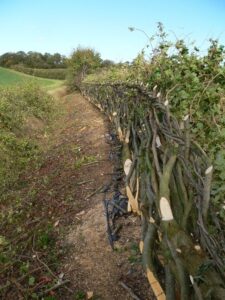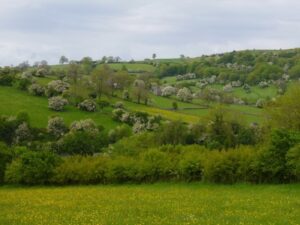Future hedgescapes for climate change mitigation and biodiversity gain
1. Introduction
Hedgerows are a key semi-natural habitat, providing resources and a refuge for plant and animal species in otherwise intensively managed agricultural landscapes (Figure 1). Agricultural intensification has resulted in the decline and loss of semi-natural habitats, including hedgerows, and in the amount of soil organic carbon (SOC) stored in soils. This has contributed to a decrease in farmland biodiversity and a large carbon (C) debt in soils.
Recent policy reports recognise the important role that hedgerows can play in mitigating climate change and restoring biodiversity in agricultural landscapes. This is because they are high diversity, linear features that accumulate C in both their woody biomass and soil. The UK Committee on Climate Change (CCC) proposed that to achieve net zero by 2050 hedgerow length will need to increase by 40% (~190,000 km across Great Britain), while the Natural England Favourable Conservation Status report for hedgerows recommended a larger increase of 60% for biodiversity gain.
In the 2007 UK Countryside Survey, over half of hedgerows in England were of poor quality (in poor structural condition). Hedgerows in good structural condition may support more species and individuals from a range of plant and animal taxa. However, we don’t currently know how hedgerow structural composition, the woody species present, hedgerow age and the landscape context may affect the plant species growing in the base of hedges, including woodland specialists. Our recent study, showed that SOC stock is controlled by hedgerow age (time since planting) until it reaches a plateau at ~40 years (Biffi et al., 2022). Using the SOC sequestration rate for 40-year-old hedges, we provided the first estimate of how much CO2 would be taken up by hedgerow biomass and soil as a result of increasing total hedgerow length by 40% in England; 10.53 Tg CO2 over 40 years. To reduce the uncertainty associated with this estimate it is important to consider the influence of soil type, climate, woody species composition and hedgerow condition and composition on C sequestration.
Improved understanding of how hedgerow species composition, structural condition, soil type, climate and landscape context influence the biodiversity and C stocks of hedgerows and whether there are trade-offs or synergies between C sequestration and biodiversity as a result of different hedgerow actions is urgently required to:
- Ascertain the role hedgerow expansion can make to UK net zero and biodiversity targets.
- Support the ongoing development and rollout of post-Brexit national agri-environment schemes (e.g., Environmental Land Management schemes) and payment for ecosystem services schemes.


Figure 1. Hedge laying in traditional management @ Jo Staley, and Hedge landscape in SW England @ Nigel Adams
2. Aim and Objectives
The major aim of this project is to assess the potential contribution of hedgerow expansion to mitigate biodiversity loss and climate change. The studentship could address the following objectives via a combination of (i) analysis of existing national datasets on hedgerow extent and plant communities, (ii) collection of new fieldwork and (iii) upscaling of results using a range of data analysis/modelling approaches:
- Evaluate using the Countryside Survey data, how hedges from different farming systems (e.g. arable vs. grassland) and regions differ in temporal changes to plant communities between 2007 and 2023, and assess whether these differences are driven by the woody species present, the quality (structural condition), and the age of hedgerows taking into account other landscape factors (such as the amount of semi-natural habitat).
- Investigate how carbon stocks and sequestration (in biomass and soil) are influenced by hedgerow condition and woody composition versus soil type, through collection of new data.
- Determine how plant community and soil properties change over the first 10 years after planting new hedges and how this may vary between farming systems, through collection of new data.
- Estimate the plant diversity and carbon stocks of the present-day hedgerow network across England (aka ‘natural capital’).
- Model the potential impact of different hedgerow expansion scenarios on climate change mitigation potential and biodiversity gain and identify trade-offs and/or synergies.
3. Training
The student will work under the supervision of Professor Pippa Chapman and Professor Guy Ziv within the School of Geography, University of Leeds and Dr Jo Staley and Dr Lisa Norton from UK Centre for Ecology and Hydrology. The successful candidate will develop a range of research skills, including experimental design, field sampling, statistical analysis and modelling, data interpretation, academic writing skills and giving presentations. Training will be provided in field health and safety procedures and the use of field equipment. In addition, the candidate will develop their understanding of (i) plant identification, (ii) processes related to the cycling and storage of carbon in hedgerow biomass and soils, and (iii) hedgerow management.
4. Student profile
The student should have a keen interest in environmental issues with a strong background in one or more of physical geography, environmental sciences, ecology, biology, soil science or related discipline. Some fieldwork experience and plant identification and statistical modelling skills are desirable but not essential, as full training will be provided during the PhD.
Please contact Pippa Chapman ([email protected]) for further information about the project.
5. Potential for impact
The outputs of this project will be of benefit to academics, conservation organisations and groups, farmers and landowners, policy development, government and society. This project will significantly advance our understanding of how current hedgerow extent, condition, age, soil type and landscape context can affect changes to biodiversity over 16 years, and stocks of carbon both in woody biomass and the soil. This will help inform government policy on agri-environment schemes for hedgerow restoration, management and planting in schemes being developed. In addition, the findings will be useful for private and NGO hedgerow planting initiatives, such as those run by the Tree Council under the Close the Gap project and Woodland Trust under MoreHedges.
6. Further Reading
Biffi S, Chapman PJ, Grayson RP, Ziv G. (2022). Soil carbon sequestration potential of planting hedgerows in agricultural landscapes. Journal of Environmental Management, 307
Biffi, S., Chapman, P.J., Grayson R., and Ziv, G. (2023) Planting Hedgerows: biomass carbon sequestration and contribution to net zero targets. Science of the Total Environment 892, 164482
Graham, L., Gaulton, R., Gerard, F. & Staley, J.T. (2018) The influence of hedgerow structural condition on wildlife habitat provision in farmed landscapes. Biological Conservation, 220, 122-131.
Staley, J. T., R. Wolton, and L. R. Norton. (2023) Improving and expanding hedgerows—Recommendations for a semi-natural habitat in agricultural landscapes. Ecological Solutions and Evidence 4:e12209.
